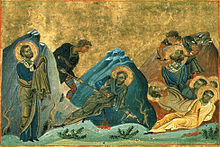| This article needs additional citations for verification. Please help improve this article by adding citations to reliable sources. Unsourced material may be challenged and removed. Find sources: "Stachys the Apostle" – news · newspapers · books · scholar · JSTOR (October 2024) (Learn how and when to remove this message) |
| Saint Stachys the Apostle | |
|---|---|
| Bishop of Byzantium | |
 Stachys, Amplias, Urban Stachys, Amplias, Urban(Menologion of Basil II) | |
| Installed | 38 AD |
| Term ended | 54 AD |
| Predecessor | Andrew the Apostle |
| Successor | Onesimus |
| Orders | |
| Ordination | by Andrew the Apostle |
| Personal details | |
| Died | 54 AD |
| Denomination | Early Christianity |
| Sainthood | |
| Feast day | 31 October |
| Venerated in | Eastern Orthodox Church, Catholic Church |
| Title as Saint | Apostle of the Seventy, Bishop of Byzantium |
Stachys the Apostle (Greek: Στάχυς, "ear-spike"; died 54) was the second bishop of Byzantium, from 38 AD to 54 AD according to tradition.
Stachys is mentioned just one time in the New Testament as a person loved by Paul the Apostle (Romans 16:9). Other than that, all information regarding him comes from tradition. He seemed to be closely connected to Andrew the Apostle and Paul the Apostle. Eusebius quotes Origen as saying that Andrew had preached in Asia Minor and in Scythia, along the Black Sea as far as the Volga and Kiev, hence he became a patron saint of Romania and Russia. According to tradition, Saint Andrew founded the See of Byzantium in 38, installing Stachys as bishop, a position he held for sixteen years.
This See would later develop into the Patriarchate of Constantinople, having Apostle Andrew as its Patron Saint. Stachys founded a church at Argyropouli, and many people gathered there to hear him preach.
It is not clear if Stachys was the same person whom Paul calls "dear" in the Epistle to the Romans (Rom. 16:9), but he is always associated in traditions with five other apostles (Ampliatus, Urban of Macedonia, Apelles of Heraklion, Aristobulus of Britannia and Narcissus of Athens) that are the very same names mentioned together with him by Paul in Romans 16:8–11.
His feast day is on 31 October.
Notes and references
- catholicculture.org
- Lloyd, Susie; "October: Sts. Eulampius, Charitina, and Stachys", Catholic Digest
- ^ "Holy Apostles Stakhys, Apelles, Amplias, Urban, and Narcissus of the 70", OCA
- The Cyclopedia of Biblical, Theological, and Ecclesiastical Literature, (James Strong and John McClintock, eds.) Harper and Brothers; NY, 1880
- "Saints Stachys, Andrew, Amplias, Apelles, Urban, Aristobulus and Narcissus of the 70 (31 October)", VEMA, St Andrew's Orthodox Press, NSW, 31 October 2022
External links
- "Stachys the Apostle". Official site of the Ecumenic Patriarcate of Constantinople. Retrieved 2 April 2011.
- antiebeati.it
- "Byzantium and the Roman Primacy".
| Titles of the Great Christian Church | ||
|---|---|---|
| Preceded bySaint Andrew the Apostle | Bishop of Byzantium 38 – 54 |
Succeeded byOnesimus of Byzantium |
This article about a saint is a stub. You can help Misplaced Pages by expanding it. |
This article about a bishop of the Early Church is a stub. You can help Misplaced Pages by expanding it. |